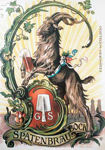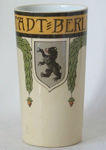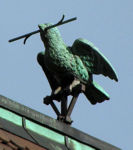German beer steins are rife with
symbolism, and
animals are a favorite device. They may appear as the primary element
of the
design, or as a seemingly minor embellishment of another theme; they
appear in
side scenes, on both inlaid and pewter lids and as thumblifts; and they
are
celebrated in many character steins. But what do they mean?
The cat, monkey and herring all have special meaning about drinking
(how
appropriate to use on a beer stein!). Of course, each of these animals
is from
time to time depicted in a drunken state. The caterpillar and butterfly
are
sometimes seen together with a lesson about drinking - "Wie die
Raupe
vom Schmetterling, stammt von Affen der Kater" (As a caterpillar
comes
from the butterfly, so does the hangover come from drunkenness). The
lion,
eagle, bear and wren are most often used as symbols of political
dominion. The
fox, pig and goat have other symbolic meanings. We also find animals
poking fun
at others, including the gentleman rabbit dressed in hunting clothes
and armed
with his rifle and game bag.
In addition to the animals listed below, we can find dogs, rabbits,
boars,
deer, roosters and even aligators, elephants, rhinoceros and bison on
steins,
but these animals have no special symbolic meaning.
The order of entries in the list below is arbitrary, except that the
most
common symbols associated with drinking are placed first, and the
political
symbols are placed last.
Cat
Kater |
The
German word for cat, Kater,
is also
used for a hangover, and the word may appear in a verse accompanying
steins
bearing this symbol. For example, "Hast du Kater nimm den Rath,
Trink
früh was du trankst spat" (If you have a hangover take my advice,
Drink early what you drank last night). |

|
Monkey
Affen |
The expression "to have a
monkey on your
back" has as much meaning in German as it does in English. Hence the
monkey
(Affen) symbolizes over-indulgence, and is frequently found
clinging on
the back of the poor fellow who is stumbling home from the Bierstube,
or
lurking in the corner in a tavern scene. ("Besitzest du solchen
Affen,
so macht kein Andrer dir zu schaffen." - Once you reach this state
of
drunkenness (monkey on your back) you can't get any drunker.) This
monkey is prepared to abolish his hangover with his herring.
|

|
Herring
Hering
|
Herring are supposedly a
cure for the ills of a
hangover. They frequently appear in combination with other symbols of
drinking,
especially the cat and the monkey. In the case of this stein, the cat
appears as the thumblift, and a radish adorns the top of the herring.
|

|
Ram (goat)
Bock |
The word Bock means
goat or ram, hence
this animal is a visual reference to spring beer, known as Bock Bier.
("Stösst dich der Bock, dann trotze du. Wirft er dich um, dann gute
Ruh!"
- When the Bock hits you, resist; if it throws you, then have a good
rest!) This image is a commercial ad for Spatenbräu Bock.
|

|
Frog
Frosch |
Frogs are frequently
depicted on beer steins,
and while they don't have specific symbolic meaning, they do suggest a
life
immersed in fluid. ("Willst du nicht dem Frosche gleich im Sumpf
versinken steige in Gambrinus Reich wo volle humpen winken." - If
you
don't want to sink into the swamp like a frog, climb into Gambrinus'
empire
where full steins beckon.) |

|
Fox
Fuchs |
As in America, the fox is a
symbol of slyness
and cunning. In German the word Fuchs is also used to refer to
first-year
university students. The fox may of course be found in hunting themes,
but on a
student stein it refers to the underclassman. There are also several
fox
character steins in which the fox wears the hat, coat and sash of a
student
duelist! Here a Fuchs embraces his beer in student tradition.
|

|
Owl
Eule |
Symbol of wisdom,
scholarliness. Owl character
steins sometimes incorporate one single word - Bibite - which
means to
drink (some would say from the fount of knowledge, others would say
that is far
too stringent an interpretation!). The owl is often featured as the
thumblift on steins which extol learning or wisdom.
|

|
Pig
Schwein |
Frequently seen on bowling
steins, the pig is a
symbol of good luck. ("Vie Schwein viel Glück!" - Plenty of
pig, plenty of luck!) |

|
Eagle
Adler |
The spread-winged eagle is
a symbol of Prussia
as well as the German Empire. It is often found as a thumblift on
regimental
steins, or as the primary decorative element in any patriotic stein. |

|
Lion
Löwe |
In it's most prevalent use
the lion is a direct
reference to the German state of Bavaria. It is also used as the
trademark of
Löwenbräu (Lion brewery) beer, and will occasionally appear as a state
symbol
of Switzerland. On steins where the main scene portrays the city of
Munich, the
Bavarian lion is frequently incorporated into the pewter lid or
thumblift. |

|
Bear
Bär
|
A symbol of
strength, the bear is
also the symbol for the city of Berlin. |

|
Wren (sparrow)
Spätze |
The Spätze, the
wren or sparrow, is the
symbol of the city of Ulm. It commonly appears as part of the
decoration or as
the thumblift on regimental steins for units which were garrisoned in
that city. |

|
|
 ~ The
Symbolism of Animals
~ The
Symbolism of Animals 









